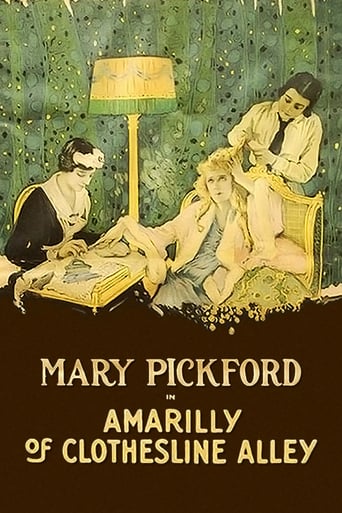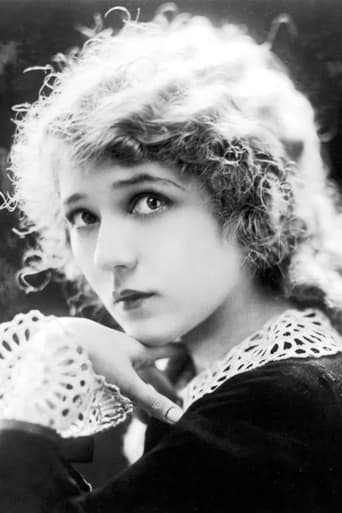

Amarilly of Clothes-Line Alley (1918)
Amarilly comes from a large family in a working-class neighborhood. She is happy with her family and her boyfriend Terry, a bartender in a cafe. But one day she meets Gordon, a sculptor who comes from a rich family, and she begins to be drawn into the world of the upper class.
Watch Trailer
Cast
Reviews
Slow pace in the most part of the movie.
People are voting emotionally.
If the ambition is to provide two hours of instantly forgettable, popcorn-munching escapism, it succeeds.
After playing with our expectations, this turns out to be a very different sort of film.
After watching a few films of her, I have to say Mary Pickford is not at her best in this movie. Mainly, this is because of the weak plot, which doesn't always seem to be coherent, especially the triangle love story, when you think about it. Furthermore, the film tries to be moralistic and funny at the same time, which doesn't seem to work really well either. However there are one or two funny scenes, whenever the washer family's mother is depicted. However, even there, it is just about exploiting stereotypes to get a few cheap laughs, or so it seems. In my opinion, one major problem are the monotone settings of the scenes, which do not vary enough to make the whole movie more interesting. All in all, it does only take an hour to watch it, but I think there are better films from 1918 than this one.
"Amarilly of Clothes-Line Alley" is a somewhat interesting film technically and is rather representative of its times. Francis Marion and Mary Pickford departed from Pickford's persona as a child character for this one, which I consider a good thing. And, Marion's scenario involving two characters from opposing social classes, two story-lines that begin separately but are destined to collide, is something that was becoming more common in cinema as a means of making social commentary. The rapid crosscutting, in addition to the extensive scene dissection (changes of camera placement within a scene), was also cutting edge.The print quality isn't the best now, the look of the images (the tinting and such) probably alters too frequently, and the editing and construction seems rather unpolished at times, but the film does remain fresh today compared to the slower films from around this time and before. This film isn't especially innovative in any of this, as D.W. Griffith probably deserves the most credit, but it is representative of the way Hollywood films were going. Future films would be less hasty in their montage, creating images that are more lasting.The social commentary isn't particularly enlightening: the rich ones come off badly, and the film mostly explores contrasts. Much in the intertitles is vernacular, too. Nevertheless, "Amarilly of Clothes-Line Alley" is entertaining enough, although the film's conclusion is odd, including Marion drawing attention to herself as the film's author. That was more up fellow screenwriter Anita Loos's alley; she unraveled Douglas Fairbanks's (soon to be Pickford's husband) comedies in clever, self-referential ways. Anyhow, Pickford is fun to watch as a lower-class hoyden in her lighter vehicles, and Kate Price is especially amusing in the supporting role of her mother in this one.
This is a charming old-fashioned story, featuring a delightful performance by Mary Pickford, two good male leads, and a plot that includes a good variety of material. The lead character makes it a perfect star vehicle for Pickford, and the rest of the film also complements her talents nicely.The story is about Amarilly, a girl from a working-class Irish family. She has a boyfriend, Terry, who works at a cafe, but she also meets a sculptor from a rich family and becomes involved with his circle. There are some very funny moments, some (melo)dramatic parts, and some thoughtful social commentary as well. All of these come together nicely in a key scene when Amarilly's family mingles with the upper crust.Besides Pickford, charming as always, the two make leads (William Scott and Norman Kerry) are very good, presenting believable and interesting characters who form a nice contrast with each other and a good complement to Amarilly. They all help a fairly simple story come to life. This is the kind of old-fashioned film that unfortunately does not get a lot of attention today, but it's a real pleasure for those who enjoy the silent classics.
Spunky little AMARILLY OF CLOTHES-LINE ALLEY has two suitors - her longtime bartender beau and a frivolous society boy. With whom would she be most happy?This urban fairy tale, with romance, heartbreak & happiness all wrapped-up into a neat package, was exactly the sort of movie that Mary Pickford's legions of fans loved to see her in. America's Sweetheart was only too happy to oblige, constantly replaying the image of a resourceful little girl or adolescent at odds with a cruel world or snobbish society. This is no disparagement or faint praise. By expertly giving the public what it wanted, Pickford became the most powerful person in Hollywood.Here, she has a fairly straightforward story line, without too many kinks in the plot. As always, Mary is imminently watchable. Whether dancing enthusiastically across a crowded floor, selling cigarettes to the `swells,' or reacting frantically to an accidental shooting, she never lets the viewer forget that the reason we watch a Pickford film is Pickford herself.William Scott gives excellent support as Terry the bartender; the feelings he has for Mary are palpably real & true. Norman Kerry, full of boisterous high jinks, is fine as the society fellow who wishes to `better' her. Special mention should be made of jolly Kate Price as Pickford's mother, the very picture of an Irish washerwoman. Her round, jovial face bespeaks the goodness of her character's soul.Pickford produced this film herself and she was ably abetted by screenwriter Frances Marion, her best friend and Marshall Neilan, her favorite director. Neilan had started his movie career as a romantic lead, but eventually moved behind the camera & Pickford considered him to be superior even to the legendary D. W. Griffith. Neilan's major failing were the frequent delays caused by his drinking, however he never failed in charming himself back into Pickford's good graces. This talented trio's collaborations continue to delight audiences today.


